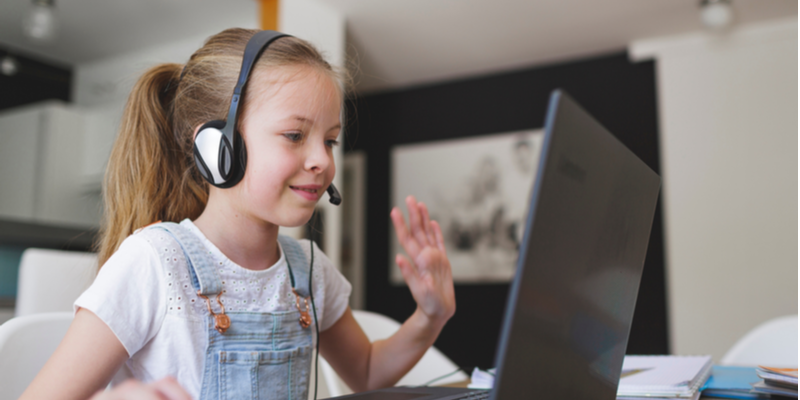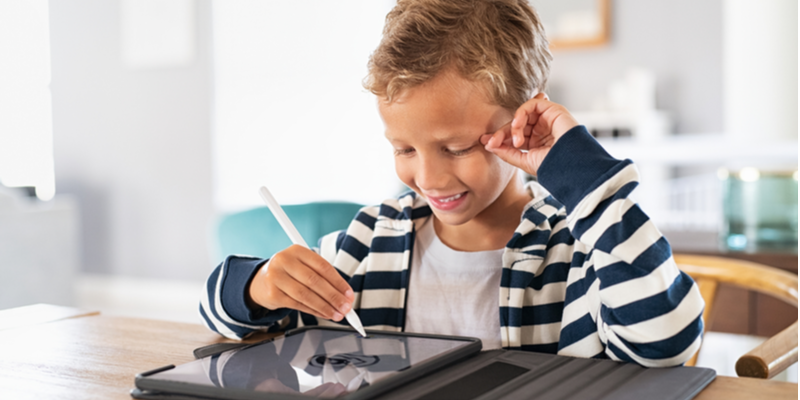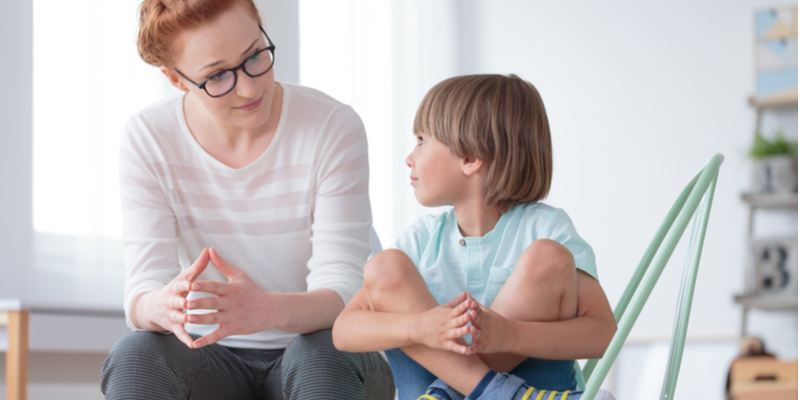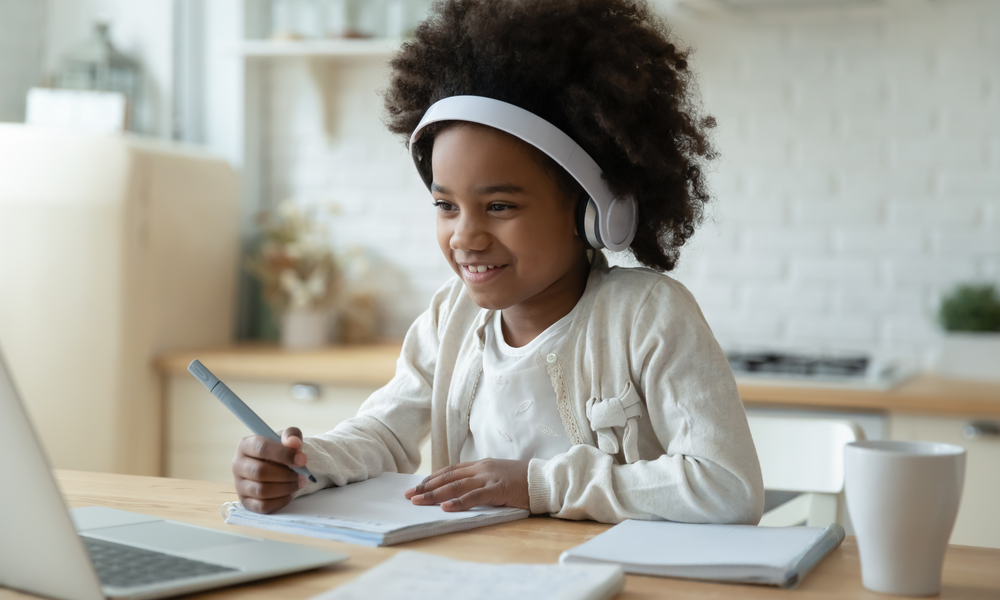Remote learning during the coronavirus pandemic means lots of screen time for our children. How do we balance the necessary screen time for schoolwork with the time our children spend gazing at screens when they are at leisure? After all, we know that too much screen time is not good for our children.
By now, it’s not news: the COVID-19 pandemic has impacted life in nearly every possible way, especially in regard to how we balance our everyday lives with our children. The need to be at home a great deal has affected everyone, bar none. Even when we venture out, social distancing guidelines have completely changed how we interact with one another. But one of the biggest changes that the coronavirus has created, is in determining how we go about educating our children from our homes.

As the impact of the pandemic has spread into schooling our children, classes from kindergarten to college have shifted to either a fully remote or a hybrid online/in-person model. This was a necessary step to avoid spreading sickness in a traditional classroom setting. Nevertheless, these steps have had the natural side effect of leaving many students and their parents scrambling to create an adequate learning environment at home.
With no end to the pandemic in sight, this new, remote-heavy homeschooling educational model provides a crucial lifeline that allows education to continue, albeit in a historically unique manner. While the current pandemic-approved format for education is a wonder of our times, one of the greatest unanswered challenges that this new emphasis on online school has created is the issue of too much screen time.
The Struggle With Screen Time
Excessive screen time for children was already a concern long before the world shifted en masse to a screen-heavy virtual school model. According to a report shared by the CDC, on average, kids between the ages of 8 and 18 spend a staggering 7.5 hours each day in front of a screen. Just to clarify, this is entertainment-related screen time that was already taking place before virtual school was soaking up additional hours of children’s time on a daily basis.
While 7.5 hours is clearly too much screen time no matter how you slice it, it is interesting to compare this to the officially recommended amount of time that a child should spend in front of a screen. Younger children, in particular, should have no more than one hour of screen time per day — and even then, only with high-quality programs (i.e. non-cartoon programs that don’t involve dumping green slime on people’s heads).

Even when parents were asked what they thought was reasonable, nearly nine out of 10 individuals responded that they thought two hours or less of entertainment screen time was a reasonable amount. And yet, children are regularly soaking up nearly four times that quantity, in addition to the time that they now spend attending school virtually, from home. In other words, some restrictions and restraints are clearly required when it comes to the triple whammy of children, online school, and screen time.
Balancing Schoolwork and Screen Time
Your children’s teachers are, hopefully, already taking steps to keep the amount of school-related screen time to a minimum. In the meantime, it falls to you, the parent, to do the best you can to complement these efforts on the home front. What follows are several suggestions on how you can help reduce your child’s screen time on a daily basis, while your children are learning from home:
Take Advantage of the Hybrid Option
The specific way that each school is choosing to operate during the pandemic varies. Most learning models revolve around one of two options:
- A completely remote option in which students do not come to school, attending classes solely online.
- A blended or hybrid option in which students attend classes in-person two or three days each week and stay at home for the other days.
Many schools are also offering both of these choices and leaving it to parents to decide with which type of schooling they’re more comfortable. It’s tempting to simply opt out of in-person classes in the name of your child’s safety. However, if you want to help reduce the number of hours that your child is spending in front of a screen, it may still be worth considering the hybrid approach.
A blended school week provides opportunities for your child to get out of the house and interact face-to-face with their teacher and fellow students. It also can be a welcome break from all the screen time necessary for the online school approach. But if you are considering the blended or hybrid route, do your homework. Make sure you’re satisfied with the social distancing and safety precautions that your particular local school is taking during in-person classes to avoid the spread of the virus.
Get Outside Every Day
It is obvious that blended/hybrid learning reduces screen time by offering some in-person classroom learning. Whatever learning route you choose for your child, however, there are many ways you can help to reduce your children’s screen time. One of the easiest steps you can take is to get children out of doors each day.

This doesn’t just get children away from screens, but puts them in an environment where they can rest their eyes by focusing on things that are far away. On top of that, being outside gives your child access to a slew of other powerful, scientifically backed health benefits that can help to counter the negative side effects of too much screen time, such as:
- An immunity boost from vitamin D.
- Decreased stress and better mental health.
- Physical activity and exercise.
- Greater creativity and life satisfaction.
- Better sleep.
Getting your child outside on a regular basis is one of the best antidotes to a school day spent online.
An Exchange: Books for Screen Time
Another great way to reduce the amount of screen time that your children soak up each day is to have them read books. If you have a child that isn’t naturally interested in reading books, you can help them develop an interest in the activity by setting up a reward system. Establish a “books for screen time exchange” in your home, such as an hour of reading for half an hour of screen-based entertainment.
This can give you a simple and concrete answer for when your kids ask to play a game on the tablet or to turn on a TV show after school. Sure they can—if they earn the time by reading something that isn’t glowing in their faces.
Go for Quality Screen Time
If you find that even with your best efforts, your child is still getting way too much screen time, you may want to focus more on the quality of that screen time rather than the quantity. Rather than allowing your kids to binge on Netflix or turn on the Disney Channel after school, try to limit their options to more constructive screen-time activities. For instance, there are many homeschooling platforms that can provide your child with an interactive, growth-oriented online environment. Learning platforms such as BrainPop, Reading Eggs, and Epic! offer loads of games, quizzes, videos, and reading suggestions. These activities will naturally challenge children and keep them from vegging out in front of the television for hours on end.

Sub Chores and Conversation for Screen Time
Even during the coronavirus pandemic, there are many household activities not requiring a screen. Things like cooking, cleaning, and personal hygiene all take place without pressing an “on” button or picking up a remote. Why not invite children to cook dinner with you, or clean a room together. Chores are not so fun, but doing them together with others makes them a lot more enjoyable. Not to mention, spending time with parents is great for bonding.

Tackling a chore together offers a chance for conversation. Just talking with your child on a regular basis will have a positive impact on their language and brain development. Too busy to do chores together with your child? Work time into your schedule to sit down with your child for weekly conversation. Parent-child conversation is wonderful way to counteract the effects of sitting in front of a screen.

Fun Activities Instead of Screen Time
Reading, chores, and conversation aside, there are many other ways that you can keep your children away from screens and happily occupied throughout the day. For instance, if you have younger children, you can:
- Make a fort.
- Do an art project.
- Play with Play-Doh.
- Listen and dance to music.
- Play hide and seek.
If you have an older child, you can encourage them to:
- Send a handwritten letter to a loved one.
- Go for a bike ride or a jog.
- Paint a picture.
- Write a story.
If you find that your own ability to come up with creative ideas stalls on occasion, you can always look to other sources to provide fresh inspiration. You can find lots of suggestions of fun non-screen activities for children on Pinterest. You might also consider looking into kid-friendly subscription boxes with toys and activities to help keep kids away from those screens.
Establishing Times to Unplug
There may be many very good reasons to use screens at the moment, but there will always be times during the day when a screen isn’t absolutely necessary. As you identify these times, consider making some of them official, family-sanctioned times when everyone must unplug. Two times that work particularly well for unplugging are:
- First thing in the morning when a lack of screens can help to set a more positive tone for the day.
- Before bed, when avoiding blue light may help kids calm down and lead to better sleep.
If your children struggle from time to time with unplugging from devices and screen time, don’t worry. It’s good to allow kids to be bored from time to time. In fact, boredom is often a primary way to spark creativity.

Set Reasonable Expectations
While there are a lot of different ideas you can try, keep things simple as you go through each day. Don’t let the desire to cut back on children’s screen time become a chore for you and a burden for your children. Try instead to work together to create family agreements that serve to keep screen time in check. It’s important to remember that we are living through unusual times. It’s okay to be lenient with screen time rules from time to time. What’s more important is to have a steady flow of grace and humor with one another as you weather the ongoing storm together.
Finding Balance While Schooling in a Pandemic
The truth is, the current situation is as unique as it gets. No one has ever lived through a pandemic with the kinds of technological tools available to us today. None of this, however, changes the fact that tech can become a double-edged sword. This is particularly true when it comes to screen time. With your children likely overloading on a perfect storm of digital schoolwork and entertainment, it’s up to you, the parents, to help regulate and restrain your child’s tech usage.
The trick is to refer to the many suggestions here and match them with your child’s particular situation and interests. Then begin the never-ending, loving process of coaxing children away from their screens whenever you can. We may not be able to do much about the pandemic, but as parents, we know that cutting back on our children’s screen time is crucial to their mental and physical well-being.
